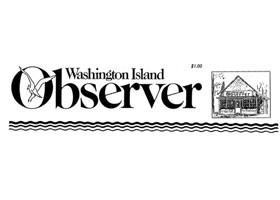
Ron and Sharon Crounse referred to this as their “wading place,” where their grandchildren were able to safely swim in the low water just this past August. However, by Oct. 10, 2012 when they took this photo, the area had dried up completely. This is the first time they have ever seen this in over 30 years of coming to the Island.
During the week of Oct. 7, 2012, Emmett Woods noticed that an underwater spring just offshore from his property was suddenly no longer underwater.
“I knew there was a spring there,” said Woods, who lives on Foss Road on the north shore of Washington Island, “because the underwater vegetation around it was always lush and green. But it had always been underwater. Now suddenly the spring was almost on dry land. And the vegetation was lying flat on the exposed lakebed.”
After a day or two the lake levels rose a bit, and Woods’ spring was once again underwater. But what happened on his property coincided with what was being reported by the U.S. Army Corps of Engineers about the record-equaling low lake levels in October.
“The U.S. Army Corps of Engineers reported on Monday that on one day last week, water levels were essentially at the lake’s official record low for October, a monthly average that was set in 1964,” the Milwaukee Journal Sentinel reported on Oct. 16, although it noted that weekend rains had brought a slight rebound of about an inch.
This dry state of affairs is not news to residents of Washington Island.
Ken Koyen, longtime commercial fisherman, said, “I had to move my boat, the Sea Diver, up toward the front of the dock in Jackson Harbor. My other boat, the Welcome, was on the bottom so hard that we had to pull it out with a truck.”
Hoyt Purinton, president of the Washington Island Ferry Line, is relieved that the water level has rebounded a bit.
“We ran the Arni J. for the first time in a little while,” commented Purinton on Oct. 24. “Some runoff from the recent rain helped. Also the overcast days suppress evaporation.”
Purinton confirmed that work on the Potato Dock has been ongoing. “Mainly we’re tightening everything up there. We want to be ready. This isn’t a panic. We want to be as proactive as we possibly can be.”
To be proactive, the WIFL has applied to the Wisconsin Department of Natural Resources for permits to dredge, if needed, in three locations: the Potato Dock, Northport and the Island dock.
“The permits are good for five years,” said Purinton. “It costs money to apply, but if things don’t get better we have to make plans for the future. We’re looking for a long-term solution.”
“The Northport situation is generally pretty good,” said Purinton. “But if the lake drops a foot, we’ll have to do something.”
Purinton commented on the quick drop in the lake level during September this year. “Day-by-day weather and wind can really make a difference,” he said.
Although not everyone agrees on the reasons for the lower lake levels, many people cite the low rainfall during recent years as contributing to the problem.
The dry weather has hurt those who depend on agriculture on Washington Island.
Ken Koyen, who grows organic wheat in addition to fishing, said, “My biggest problem is the light snow cover in the winter. For the past four years in a row my winter wheat has been freezing out.”
Joe Elmore, who has 40 head of cattle and who grows oats, corn and hay, said, “The main effect is that this year there wasn’t much grass for the cattle. I had to start feeding hay earlier this year.”
Last year Elmore started feeding hay on Oct. 24, he said, but this year he started in mid-September.
In addition, this year Elmore got only one cutting of hay instead of three.
“Usually we cut hay three times. The first cutting is the largest and the second and third are of higher quality. But this year we were able to cut it only once – in mid-June. It was short but all right. But there weren’t any second and third cuttings. I had to buy additional hay for the winter. Fortunately I did it early, and I also have some carryover from last year. I think I have enough to get through the winter.”
“The lack of moisture. That’s the issue,” said Elmore. “The rains in the last couple of weeks have been a blessing.”
By Mary Marik
Click here for Washington Island Observer subscription info.




